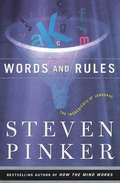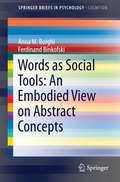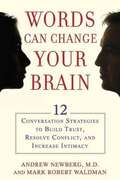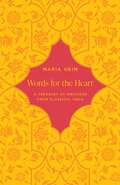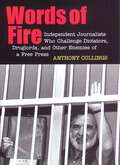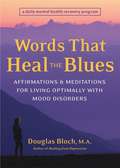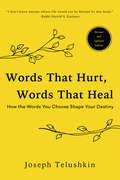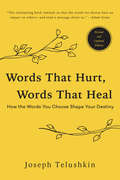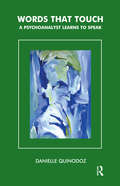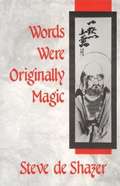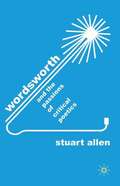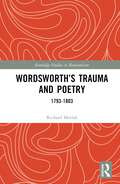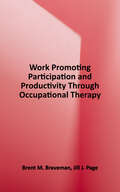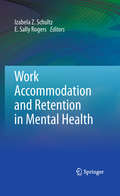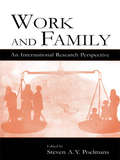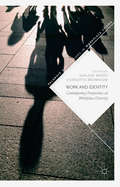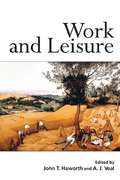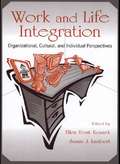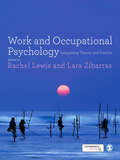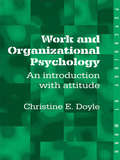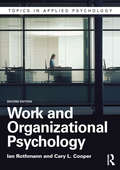- Table View
- List View
Word Processing for Technical Writers (Baywood's Technical Communications Ser.)
by Robert KrullSupports the idea of matching the "system" to the technical writer's needs. This book contains numerous questions and answers.
A Word to the Wise: Don Quixote Returns to Fight Perversion
by Françoise Davoine Jean-Max GaudillièreAfter giving us a fascinating reading of Cervantes' classic novel in Don Quixote: Fighting Melancholia, Françoise Davoine and Jean-Max Gaudillière co-author a second work, to reflect on the hero's battle against perversion. To do so, they retrace his adventures in the Cervantes' second Don Quixote, written ten years after the first. The authors follow in his footsteps as he embarks on this other extraordinary journey in which perversion is laid bare for all to see, creating not only a powerful social link, but even a form of government. Cervantes shows us how madness acts as a means to confront it: here again, the field of action presented to the reader is explored in rigorous detail. The reliability of this strategy derives from the power of the given word, which has to oppose lies, seduction, secrets, trickery and crime, in order to confer authenticity to what madness reveals.
Words and Rules: The Ingredients of Language
by Steven PinkerPinker (psychology, MIT) explains the mysteries of language, such as why languages change over time and how children learn their native language, by dissecting the idea that language comprises a mental dictionary of memorized words and a mental grammar of creative rules. Pinker connects a remarkable number of topics such as the attempts to simulate language using computers; the nature of human concepts; the peculiarities of the English language; and the theories of Noam Chomsky, through a minute dissection of the phenomenon of regular and irregular verbs. Annotation c. Book News, Inc., Portland, OR (booknews.com)
Words as Social Tools: An Embodied View on Abstract Concepts
by Anna M. Borghi Ferdinand BinkofskiHow are abstract concepts and words represented in the brain? That is the central question addressed by the authors of "Words as Social Tools: An Embodied View on Abstract Concepts". First, they focus on the difficulties in defining what abstract concepts and words are, and what they mean in psycholinguistic research. Then the authors go on to describe and critically discuss the main theories on this topic with a special emphasis on the different embodied and grounded theories proposed in cognitive psychology within the last ten years, highlighting the advantages and limitations of each of these theories. The core of this Brief consists of the presentation of a new theory developed by the authors, the WAT (Words As social Tools) view, according to which both sensorimotor (such as perception, action, emotional experiences) and linguistic experiences are at the basis of abstract concepts and of abstract word representation, processing and use. This theory assigns a major role to acquisition: one of the assumptions the authors make is that the different ways in which concrete and abstract words are acquired constrain their brain representation and their use. This view will be compared with the main existing theories on abstractness, from the theory of conceptual metaphors to the theories on multiple representation. Finally, the volume illustrates recent evidence from different areas (developmental, behavioral, cross-cultural, neuropsychological and neural) which converge with and support the authors' theory, leading to the conclusion that in order to account for representation and processing of abstract concepts and words, an extension of embodied and grounded theories is necessary.
Words Can Change Your Brain: 12 Conversation Strategies to Build Trust, Resolve Conflict, and Increase Intimacy
by Andrew Newberg Mark Robert WaldmanIn our default state, our brains constantly get in the way of effective communication. They are lazy, angry, immature, and distracted. They can make a difficult conversation impossible. But Andrew Newberg, M.D., and Mark Waldman have discovered a powerful strategy called Compassionate Communication that allows two brains to work together as one.<P><P> Using brainscans as well as data collected from workshops given to MBA students at Loyola Marymount University, and clinical data from both couples in therapy and organizations helping caregivers cope with patient suffering, Newberg and Waldman have seen that Compassionate Communication can reposition a difficult conversation to lead to a satisfying conclusion. <P>Whether you are negotiating with your boss or your spouse, the brain works the same way and responds to the same cues. The truth, though, is that you don't have to understand how Compassionate Communication works. You just have to do it. Some of the simple and effective takeaways in this book include: * Make sure you are relaxed; yawning several times before (not during) the meeting will do the trick * Never speak for more than 20-30 seconds at a time. After that they other person's window of attention closes. * Use positive speech; you will need at least three positives to overcome the effect of every negative used * Speak slowly; pause between words. This is critical, but really hard to do. * Respond to the other person; do not shift the conversation. * Remember that the brain can only hold onto about four ideas at one time Highly effective across a wide range of settings, Compassionate Communication is an excellent tool for conflict resolution but also for simply getting your point across or delivering difficult news.
Words for the Heart: A Treasury of Emotions from Classical India
by Maria HeimA richly diverse collection of classical Indian terms for expressing the many moods and subtleties of emotional experienceWords for the Heart is a captivating treasury of emotion terms drawn from some of India’s earliest classical languages. Inspired by the traditional Indian genre of a “treasury”—a wordbook or anthology of short texts or poems—this collection features 177 jewel-like entries evoking the kinds of phenomena English speakers have variously referred to as emotions, passions, sentiments, moods, affects, and dispositions. These entries serve as beautiful literary and philosophical vignettes that convey the delightful texture of Indian thought and the sheer multiplicity of conversations about emotions in Indian texts. An indispensable reference, Words for the Heart reveals how Indian ways of interpreting human experience can challenge our assumptions about emotions and enrich our lives.Brings to light a rich lexicon of emotion from ancient IndiaUses the Indian genre of a “treasury,” or wordbook, to explore the contours of classical Indian thought in three of the subcontinent’s earliest languages—Sanskrit, Pali, and PrakritFeatures 177 alphabetical entries, from abhaya (“fearlessness”) to yoga (“the discipline of calm”)Draws on a wealth of literary, religious, and philosophical writings from classical IndiaIncludes synonyms, antonyms, related words, and suggestions for further readingInvites readers to engage in the cross-cultural study of emotionsReveals the many different ways of naming and interpreting human experience
Words of Fire: Independent Journalists who Challenge Dictators, Drug Lords, and Other Enemies of a Free Press
by Anthony C. CollingsIf journalism is the first draft of history, then independent journalists are surely its most daring composers.Along such celebrated and high-profile figures as Christiane Amanpour and Wolf Blitzer, there exists a stratum of journalists self-employed, working under dire conditions, and with minimal resources who often place themselves at ground zero of world events. In this gripping account, Anthony Collings takes us into the world of independent journalists, and the daily challenges they face confronting dictators, hostile military, and narcoterrorists. Unfettered by any ties to those in positions of power, these guerrilla journalists are often the first on a story whether reporting on corruption in Mexico, organized crime in Russia, or sexual scandal in the Middle East and accordingly face the brunt of their subject's wrath.Collings, who has himself been held captive while on assignment, here focuses less on those nations in which the press is either largely free (such as the U.S. or Western European democracies) or aggressively restricted (as in China), and more on those "battleground countries" where the eventual outcome of the struggle between state and fourth estate remains unclear. Relying on interviews, professional contacts, and his own experiences, Collings explores the dilemmas and strategies of journalists who persevere in the face of war, repressive governments, and criminal aggression, with particular emphasis on the role of the Internet.At a time when journalism is increasingly a profession under siege, Words of Fire forces into the spotlight a more positive side of the profession, those who pursue journalism not for profit or fame but as a personal crusade.
Words That Heal the Blues: Affirmations and Meditations for Living Optimally with Mood Disorders
by Douglas Bloch"Affirmations (positive self-statements) are a simple and time-proven way of redirecting the mind to accentuate the positive. When you turn your mind to something positive and life affirming, the negative has no place in your mind to dwell. It's as if the neurons literally light up a different pathway or circuit in the brain. The repetition of affirmations over time will change negative, fear-producing thoughts into positive, uplifting ones, thereby leading to a change in mood." -from the IntroductionEvery thought produces a neurochemical reaction that in turn affects the way we feel. With this in mind, author and counselor Douglas Bloch developed a daily program of self-care strategies to enhance one's mood. Based on his best-selling book WORDS THAT HEAL, WORDS THAT HEAL THE BLUES uses the power of daily affirmations to alleviate the painful symptoms of depression, anxiety, addiction, and other mood disorders. Each day includes a self-care lesson, a series of affirmations, and an activity to help transform the lesson into positive action. These healing words will comfort and inspire you to let go of fear and worry, and let wellness and harmony into your life, one day at a time. Includes a 30-day program for alleviating depression, anxiety, and negative thoughts and feelings, from the author of HEALING FROM DEPRESSION. According to the Surgeon General, 22 percent of all Americans experience a mental or emotional disorder in any given year, and 50 percent do so in their lifetime. Lessons include "Setting the Intention to Heal," "Letting Go of Worry," "Overcoming the Stigma of Depression," and "Finding Your Purpose." The original Words That Heal sold more than 85,000 copies and has been translated into five languages.From the Trade Paperback edition.
Words That Hurt, Words That Heal: How To Choose Words Wisely And Well
by Joseph TelushkinJoseph Telushkin is renowned for his warmth, his erudition, and his richly anecdotal insights, and in Words That Hurt, Words That Heal he focuses these gifts on the words we use in public and in private, revealing their tremendous power to shape relationships. With wit and wide-ranging intelligence, Rabbi Telushkin explains the harm in spreading gossip, rumors, or others' secrets, and how unfair anger, excessive criticism, or lying undermines true communication. By sensitizing us to subtleties of speech we may never have considered before, he shows us how to turn every exchange into an opportunity. Remarkable for its clarity and practicality, Words That Hurt, Words That Heal illuminates the powerful effects we create by what we say and how we say it.
Words That Hurt, Words That Heal, Revised Edition: How the Words You Choose Shape Your Destiny
by Joseph TelushkinFrom the New York Times bestselling author of Rebbe comes this newly revised edition of Words That Hurt, Words That Heal—an invaluable guide in how choosing the right words can enrich our relationships and give us insight to improve every facet of our lives.“I don’t know anyone whose life would not be blessed by this book.”—Rabbi Harold S. Kushner, author of When Bad Things Happen to Good People and Nine Essential Things I’ve Learned About Life Joseph Telushkin is renowned for his warmth, his erudition, and his richly anecdotal insights, and in Words That Hurt, Words That Heal he focuses these gifts on the words we use in public and in private, revealing their tremendous power to shape relationships. With wit and wide-ranging intelligence, Rabbi Telushkin explains the harm in spreading gossip, rumors, or others’ secrets, and how unfair anger, excessive criticism, or lying undermines true communication. By sensitizing us to subtleties of speech we may never have considered before, he shows us how to turn every exchange into an opportunity.In this fully revised edition, Joseph Telushkin brings this classic into the modern age. Remarkable for its clarity and practicality, Words That Hurt, Words That Heal illuminates the powerful effects we create by what we say and how we say it.
Words That Touch: A Psychoanalyst Learns to Speak
by Danielle QuinodozIn her attempt to find the words that touch, the author gives a succession of illuminating examples to indicate what a psychoanalyst and her patient may experience in the transference relationship during the course of an analysis. On the basis of her clinical experience, the author points out that we all use relatively mature psychic mechanisms and others of a more primitive nature, the former being accessible to symbolism and the latter less so. However, she notes that some can tolerate the awareness of their heterogeneity even if on occasion it causes them pain, while others are rendered so anxious by their lack of inner cohesion that they are afraid of losing their sense of identity. These people particularly need to be touched by words capable of simultaneously evoking fantasies, thoughts, feelings and sensations if they are to be able to unfold their psychic freedom and creativity to the full.
Words Were Originally Magic
by Steve De ShazerIn explicating how language works in therapy, De Shazer ranges widely, citing and critiquing Lacan, Bateson, Ackerman, and Weakland, among others. But the heart of this book can be found in the detailed conversations between client and therapist that show solution-focused therapy in action.
Wordsworth and the Enlightenment Idea of Pleasure
by Rowan BoysonAncient questions about the causes and nature of pleasure were revived in the eighteenth century with a new consideration of its ethical and political significance. Rowan Boyson reminds us that philosophers of the Enlightenment, unlike modern thinkers, often represented pleasure as shared rather than selfish, and she focuses particularly on this approach to the philosophy and theory of pleasure. Through close reading of Enlightenment and Romantic texts, in particular the poetry and prose of William Wordsworth, Boyson elaborates on this central theme. Covering a wide range of texts by philosophers, theorists and creative writers from over the centuries, she presents a strong defence of the Enlightenment ideal of pleasure, drawing out its rich political, as well as intellectual and aesthetic, implications.
Wordsworth and the Passions of Critical Poetics
by Stuart AllenThis scholarly study presents a new political Wordsworth: an artist interested in 'autonomous' poetry's redistribution of affect. No slave of Whig ideology, Wordsworth explores emotion for its generation of human experience and meaning. He renders poetry a critical instrument that, through acute feeling, can evaluate public and private life.
Wordsworth’s Trauma and Poetry: 1793–1803 (Routledge Studies in Romanticism)
by Richard E. MatlakBased upon the testimony of Thomas Carlyle, most biographers acknowledge that Wordsworth witnessed the beheading of the journalist Antoine Gorsas in October 1793 during the Reign of Terror. But they go no further. This study reads the Poet’s reactions to the Terror in passages from The Prelude as explicitly about his twenty-three-year-old-self witnessing the gory deaths of Gorsas and others, which caused post-traumatic stress disorder and its symptoms, exacerbated by guilt for abandoning his French lover and their child a year earlier. Following a chronological arc from October 1793, when the trauma began, until its conclusion in October 1803, when Wordsworth became a poet-soldier, I examine poetic works from The Borderers (1796), the “Discharged Soldier’ (1798), the Two-Part Prelude (1799), Home at Grasmere (1800), and the Liberty sonnets (1803), to follow the Poet working through anxiety, fear, and remorse to a resolution.
Work: Promoting Participation and Productivity Through Occupational Therapy
by Brent M. Braveman Jill J. PageHere's the first book of its kind to provide a comprehensive overview of the full range of occupational therapy interventions for work-related services. The authors build a foundation of knowledge based on the development of the worker role, the meaning and function of work in modern-day society, and cultural interpretations of work. They then focus on specialized areas of occupational therapy assessment and intervention, including psychosocial and physical assessment and preventative programming.
Work Accommodation and Retention in Mental Health
by Izabela Z. Schultz E. Sally RogersGrowing interest in the field of mental health in the workplace among policy makers, clinicians, and researchers alike has been fueled by equal employment rights legislation and increasing disability statistics in mental heath. The importance of addressing this topic is underscored by the fact that depression now ranks second on the hierarchy of occupational disabilities. The problem is compounded by a host of factors, including major difficulties in job retention and productivity experienced by persons with mental health disabilities; younger age and higher education of persons with mental health problems; and labor shortages and an aging workforce in many industrialized countries. In addition, particularly in the United States, the vocational needs of army veterans returning from duty with mental health disorders require system-based solutions and new rehabilitation approaches. The pressure created by these powerful legislative, societal, and economic forces has not been matched by the state of evidence-based practices in the field of employment retention and job accommodation in mental health. Current research evidence is fragmented, limited in scope, difficult to access, and adversely affected by the traditional divide between the fields of psychiatry and psychology on one hand and interdisciplinary employment research and practices on the other. As a result, policy makers, employers, disability compensation systems, and rehabilitation and disability management professionals have been left without a critical "how to" evidence-informed toolbox for occupational practices to accommodate and retain persons with mental health disabilities in the workplace. Currently, no single source of knowledge and research evidence exists in the field that would guide best practices. Yet the need for workplace accommodations for persons with mental health disabilities has been growing and, based on epidemiological trends, is anticipated to grow even more in the future. These trends leave physicians, psychologists, occupational therapists, vocational rehabilitation professionals, disability managers, human resource professionals, and policy makers poorly prepared to face the challenge of integrating and maintaining persons with mental health disabilities in the workplace. The aim of the Handbook is to close the gap between the needs of the professionals and networks that work with or study persons with mental heath disorders in an employment context and the actual knowledge base in the field. The Handbook will be written in language that can easily be understood by readers representing a multitude of disciplines and research paradigms spanning the mental health, rehabilitation, and employment fields of inquiry. The Handbook will contribute an integration of the best quantitative and qualitative research in the field, together with experts' consensus, regarding effective work retention and accommodation strategies and practices in mental health. The book will consist of five major sections, divided into chapters written by recognized experts in these areas.
Work and Family: An International Research Perspective (Applied Psychology Series)
by Steven A. Y. PoelmansThe entrance of women into managerial positions in significant numbers brings work and family issues to center stage, shifting the spotlight from issues of entry and equality of access to the consideration of the work-family conflicts and the difficulties posed on female managers. Looking at new approaches to enhance the work-family interface individually and in the firm, Work and Family: An International Research Perspective:*provides an overview on the antecedents of work-family conflict and the major consequences of work-family conflict, for well-being, productivity, and the strength of the relationship with the firm;*discusses the migrant's work and family experiences in terms of the demands, opportunities, and constraints they face and the role of work-family culture in reconciling the demands of work and family in organizations;*presents descriptive data concerning the linkages between work-family pressure and several known correlates and the differences in reported levels of each of these variables;*explores the work-life balance challenges and opportunities created by global assignments;*examines the work-family interface of the Western model and urban sub-saharan Africa;*emphasizes the importance of organizational change to the dynamics of work-family policies; and*highlights the progress in moving the field toward an open-systems perspective.Written by well-known contributors, this book offers international research in order to test the models mostly developed in the United States. In addition, it develops new models to capture the complexity and diversity of work-family experiences around the globe and explores cross-cultural topics.
The Work and Family Handbook: Multi-Disciplinary Perspectives and Approaches
by Ellen Ernst Kossek Marcie Pitt-Catsouphes Stephen SweetThe Work and Family Handbook is a comprehensive edited volume, which reviews a wide range of disciplinary perspectives across the social sciences on the study of work-family relationships, theory, and methods. The changing demographics of the labor force has resulted in an expanded awareness and understanding of the intricate relations between work and family dimensions in people's lives. For the first time, the efforts of scholars working in multiple disciplines are organized together to provide a comprehensive overview of the perspectives and methods that have been applied to the study of work and family. In this book, the leading work-family scholars in the fields of social work, psychology, sociology, organizational behavior, human resource management, business, and other disciplines provide chapters that are both accessible and compelling. This book demonstrates how cross-disciplinary comparisons of perspective and method reveal new insights on the needs of working families, the challenges faced by those who study them, and how to formulate policy on their behalf.
Work and Identity: Contemporary Perspectives On Workplace Diversity (Palgrave Explorations In Workplace Stigma Ser.)
by Shalene Werth Charlotte BrownlowThis edited volume highlights relevant issues and solutions for diversity groups within the workplace. It explores issues of identity as they relate to attributes of gender, age, migrant labor, disability, and power in social spaces. Identity is rarely well-defined in many social spaces, and understandings that define belonging are often developed through the normative expectations of others. Having an evidence-based approach in addressing these relevant issues, this book will appeal to academics and practitioners alike looking for practical and theoretical solutions to improving the situations of these groups in paid employment.
Work and Leisure
by A. J. Veal John T. HaworthGlobalization, economic development and changes in social environments have put the relationships between work, leisure, social structure and quality of life under the spotlight. Profound transformations in the nature and organization of work are occurring, with potentially far-reaching social and economic consequences. Increasingly, organizations demand greater flexibility from their workforces and are introducing new technologies and practices in response to global competitive pressures. At the same time many employees are experiencing long working hours, increasing workloads and job insecurity, along with the challenge of balancing work and domestic responsibilities. These changes threaten long-term gain in leisure time while, simultaneously, the leisure environment is also changing radically, as we see increasing commercialization and professionalization of leisure services and experiences, the influence of the Internet, the rise of gambling and the decline of community-based activity. Exploring all of these issues, this book brings together specially commissioned chapters from international experts in a wide range of disciplines concerned with work, leisure and well-being. Each author takes stock of the current position, identifies core practical and theoretical issues and discusses possible future trends in order to provide an invaluable resource for all policy-makers, educators, employers and researchers in the field.
Work and Life Integration: Organizational, Cultural, and Individual Perspectives (Applied Psychology Series)
by Ellen Ernst Kossek Susan J. LambertWork-family researchers have had much success in encouraging both organizations and individuals to recognize the importance of achieving greater balance in life. Work and Life Integration addresses the intersect between work, life, and family in new and interesting ways. It discusses current challenges in dealing with work-life integration issues and sets the stage for future research agendas. The book enlightens the research community and informs the public debates on how workplaces can be made more family sensitive by providing contributions from psychologists, sociologists, and economists who have not shied away from asserting the policy implications of their findings.This text appeals to both practitioners and academics interested in seeking ways to create meaningful lives.
Work and Occupational Psychology: Integrating Theory and Practice
by Rachel Lewis Lara ZibarrasWork and Occupational Psychology is the ideal companion for any student of the field, whether they are studying for a postgraduate qualification with a view to working in OP, or taking the subject as part of a wider degree programme at any level.<P><P> Written by a team of experts and with contributions from seminal academics and leading practitioners, this text provides the concise link between theoretical learning and the key practical skills needed to increase your grades and your employability.<P> Features of this book include:<P> - Structured around the eight core areas of Occupational Psychology to ensure a rounded overview and enables students to dip in and out of the text<P> - Assumes no prior knowledge of the subject making it ideal for anyone studying Occupational Psychology for the first time<P> - Provides a contemporary and future-facing account of the field, including cutting edge research and reflections on future of Occupational Psychology<P> - Reflects the realities of a global workplace through discussion of international and cross-cultural issues and a range of international case studies<P> - Engages critically with the subject to encourage analytical thinking<P> - Comes with a range of accessible in-text and online learning features including essay/exam questions, access to full text SAGE journal articles, podcasts and a glossary.<P> Visit the Companion Website at www.sagepub.co.uk/zibarras
Work and Organizational Psychology: An Introduction with Attitude
by Christine DoyleIn this unique text, Christine Doyle provides the student with a cutting-edge introduction to the field of work and organizational psychology. The main focus is on recent changes that have occurred in the world of work, incorporating their causes, consequences, proposed solutions to the associated problems, and above all, the challenges they pose for work and organizational psychology.Among the topics covered are motivation at work, the concept of stress, and the causes of individual accidents and organizational disasters. Solutions to such problems might include lifelong learning and training, performance management, career development, and employee assistance programmes.This lively, provocative, and highly readable book will be an essential resource for advanced undergraduate and postgraduate students of work and organizational psychology, as well as business management students, managers and anyone with an interest in human resources management.
Work and Organizational Psychology
by Ian Rothmann Cary L. CooperPsychologists have been fascinated by the world of work, and the changing relationship between people, technology and the workplace, since the onset of the industrial revolution. And in providing a complete and contemporary overview of this evolving and fascinating field, the new edition of Work and Organizational Psychology is the perfect textbook, outlining not only the key theoretical ideas, but also how they relate to the role of psychologists advising today’s organizations. The only textbook to integrate the fields of HRM and organizational behaviour, the new edition is thoroughly revised to cover new technological advances such as virtual workplaces and virtual employees. In an era of rapid socio-economic change, there is also expanded coverage of the role of workplace diversity, employee commitment and globalization, as well as updated chapters on key concepts such as motivation, leadership, group behaviour and well-being at work. Also including a chapter on career development, the book is supported by a range of pedagogical features, spotlighting issues of theoretical, ethical or contemporary interest, whilst also enabling students to engage in active learning. Lucid and comprehensive, the second edition of Work and Organizational Psychology will be the cornerstone for any student of this dynamic field.


